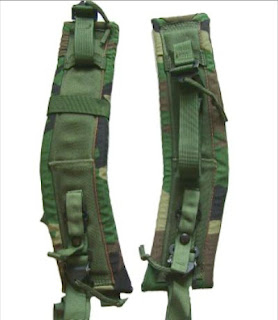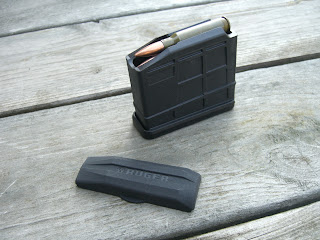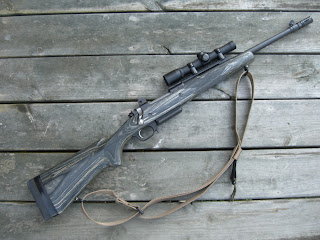Ruger finally introduced it's much anticipated polymer magazine for it's popular Gunsite Scout Rifle in mid to late October. Once on sale at the Ruger web store I ordered one each of the 3 round, 5 round, 10 round magazines. They arrived last week, which has given me some time to evaluate them; and to also read criticisms posted on various forums.
At first glance they appear to be well made and thought out. I noted they were of similar quality and build of a PMag with familiar appointments. The 20 round Pmag is to the far right.
Ruger Mag with dust cover attached
Side by side of Ruger mag and PMag floor plate with familiar latch location
I immediately took the 3 round magazine and began to load it with mil surp ammo. The first thing that struck me was how easy the magazines were to load. Each round, from first to last slipped in with very little effort. The experience was unlike using the steel magazines, which take considerable effort, and utterances of explicatives which I will not pen here. At first, I thought it must be the 3 round magazine; to my delight the 5 and 10 round magazines loaded with similar ease.
Inserting the magazines into the mag well met with familiar exercise I find with all polymer mags. As expected, I found the polymer magazine was much handier and required less manipulation to engage the well opening than the steel counterparts. I did notice the 5 and 10 round magazines required a slight "pop" with the palm of the hand to seat properly; but this is not an uncommon occurrence for anyone who has used PMags or other polymer AR15 magazines. Removal of the magazines met with little resistance; the 5 and 10 rounders dropped effortlessly. The 3 round magazine did require manual removal due to its lighter weight and not wanting fall out freely.

Close inspection the 5 and 10 round magazines revealed slight indentations running the length of the feed lips. This in my opinion was of no consequence. It is merely where the feed lips came in contact with the receiver rails at the top of the mag well. If you find it unsightly a little emory paper will smooth it down. No different than any other poly mag I have ever used.
One pleasant surprise was the ability to top load the rifle with the magazine engaged. The feed lips have a slight inner camfor that allow the cartridges to be loaded from the top; thus addressing an early criticism of Ruger's decision to use the AI magazine system:
"Not being able to top off the magazine while engaged in the rifle."
Cycling the bolt proved to be much smoother and I did not encounter any rounds hanging at the feed ramp as I did with the steel magazines. These three things alone are a vast improvement over the steel magazines.
Taking a look at the magazines side by side with their steel counter parts also revealed a few surprises.
Obviously the 3 round magazine has a much lower profile than any of the others; the surprise came with the 5 and 10 round magazines. The 5 round poly magazine is actually taller than the the 5 round steel and the 10 round poly was surprisingly shorter than the 10 round steel. I was also a bit taken back as to the weight difference between the steel and polymer magazines. If I had thought about it before hand it should have been no surprise; but on comparison it was quite revealing.
* Ruger poly mags measured w/o the dust cover
From the chart above you can see that both the 5 and 10 round poly magazines are less than 50% of the weight of the steel magazines. However, the 5 round poly magazine is slightly larger in profile than the 5 round steel; and the 10 round poly is 1 inch shorter than the steel. So, no improvement on the 5 round poly profile but a significant improvement on weight. Double so with the 10 round poly magazine.
The next few pics compare the Ruger GSR with the poly and steel magazines. I like the look of the poly magazines better than the steel. But beauty is in the eye of the beholder.
GSR with 3 rd Ruger poly
GSR with 5 rd Ruger poly
GSR with 5 rd Ruger steel
GSR with 10 rd Ruger poly
GSR with 10 rd Ruger steel
The last thing that I did was to disassemble the Ruger poly magazine. The steel magazine is a hit and miss when it comes to disassembly. Both my Ruger steel mags require quite a bit of muscle and one always runs the risk of either personal injury or damaging the magazine; both being distasteful.
Disassembly was very simple and did not require anything more than a pencil, pen, small stick or bullet tip. Anything that will depress the latch in the center of the floor plate.
Once depressed the floor plate slides off easily and reveals three inner parts: follower; spring, and base. All three are easily detached from one another for cleaning; repair or replacement.
3 rd mag disassembled
Spring assembly
Spring, follower and base
From my vantage point I believe the Ruger polymer magazine offers significant improvement over the steel magazines. They offer a lot of positives and I really can't find a negative at this point.
Pros
lighter
easier to load cartridges
easier to engage
offers top loading
smoother bolt operation
simple to disassemble
Cons
I guess I'll have to run the magazines for a while to find any. I'm sure something will raise up; if and when it dose I'll post a follow up with close examination.
I believe Ruger has a winner magazine that is every bit as well thought out as the rifle it is mated to. Nothing is perfect, but right now I can find no fault. BTW, did I mention the the new magazine is less expensive than the steel mags. $39.95. About 30% less than steel. There are a number things that are "lesser" with the Ruger poly magazine but in this case ........... less is more.
UPDATE
Top loading the new Ruger polymer magazine is officially sanctioned by Ruger Firearms. The following is a link to videos found on the Ruger website. They are informative and may clear up any misconceptions or concerns regarding function and durability. I would caution exclusively loading the magazine from the top. Limit top loading only when the magazine is in the rifle and needs to be "topped off" with one or two rounds. This will reduce premature wear on the feed lips(this comes on good authority from within Ruger)
UPDATE: December 20, 2011
After using the magazines since I first published this article; there appears to be some failure to feed problems primarily with the 5 and 10 round magazines. Several forum members on
scoutrifle.org have reported rounds not engaging the bolt face and jamming/failing to feed into the chamber. I'll admit I had yet to use my 10 round magazine fully loaded; so I pulled it out, topped it off, and stated to cycle rounds and began to experience the same issues.
When cycling the bolt the first 2 or 3 rounds chambered without problems; however, getting further into the magazine I began experiencing the same issues others were having. When the bolt was cycling I noticed the face would would miss the base of the round completely or would barely catch the rim and would cause the cartridge to swing slightly off axis and jam at the mouth of the chamber. The steel mags do not appear to cause the same failure to feed.
So, I recalled an observation I made in my initial examination of the Ruger Poly mags. If you read my above article you will notice a pic of marks made on the feed lips of the poly mag. They are caused by contact with the rails in the mag well.
At the time I felt it would be of no consequence; however I did think in the back of my mind that the mags had the potential of not fully engaging all the way into the mag well and not allowing the bolt to engage the base of the cartridge properly. Since the rounds cycled without issue in my initial test I thought no more of; until others started experiencing FTT's. As I stated above, I pulled my 10 round mag and found the same FTT's the others were having.
What now you ask?
For me the solution was, and is simple. Just remove a little material from the outside of the feed lips so the magazine engages the mag well properly. I went to my garage and got a small section of 150 grit sand paper and a sanding block; and then carefully sanded the marks away on both feed lips. No surprise to me, the FTT's went away.
Hopefully Ruger will be addressing the FTT issue and come up with a resolution. For now, a little sand paper will take away the excess material, but many gun owners will not be comfortable altering the magazine in this manner and it may void the warranty. Like I promised I'll keep this post updated as I gain more info and solutions.
UPDATE: April 9, 2013
A lot has happened since my last post on this subject. First Ruger has increased the strength of the follower spring to address feeding issues. This has been well received by the GSR community. Magazines seem to function without jamming as first reported. Second, It was discovered shortly after I made my initial post that the magazine latch on the GSR shares similar dimensions with the Mini 14 magazine latch. It appears(per Ruger) that a undisclosed number of Mini 14 latches were installed on the GSR during early production; which may have contributed to some of the FTF problems with the polymer magazines. This has been addressed by Ruger and fixed. If you have FTF's still please contact Ruger with the rifle S/N to see if it falls into this category. I have had nothing but positive things to say about Rugers customer service; it is one of the best in the industry.

















































